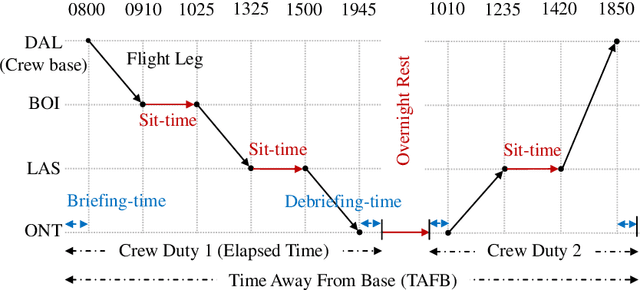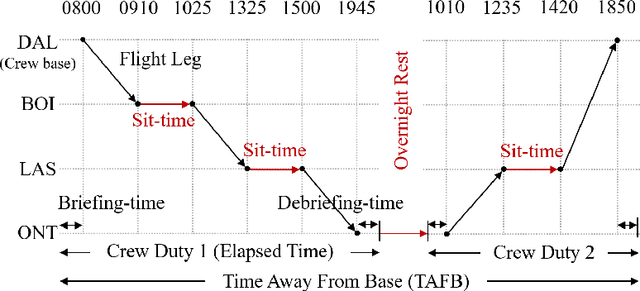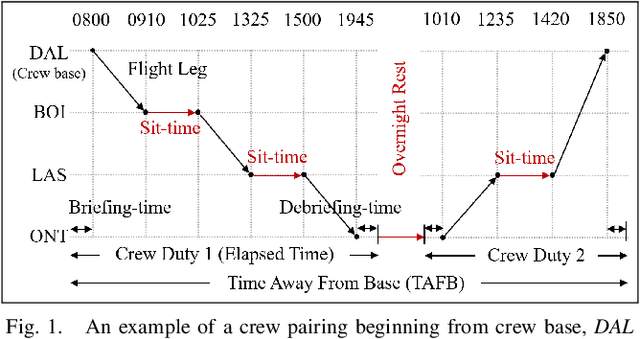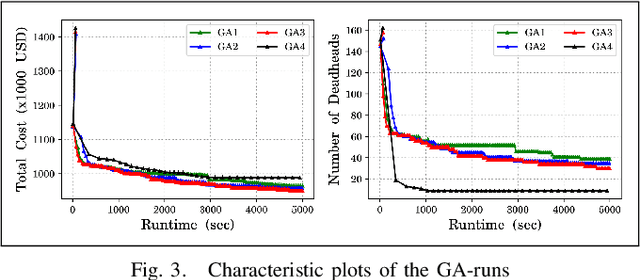Divyam Aggarwal
A Novel Column Generation Heuristic for Airline Crew Pairing Optimization with Large-scale Complex Flight Networks
May 23, 2020



Abstract:For a large-scale airline, the crew operating cost is second only to the fuel cost. This makes the role of crew pairing optimization (CPO) critical for business viability. Here, the aim is to generate a set of flight sequences (crew pairings) which cover a finite set of an airline's flight schedule, at minimum cost, while satisfying several legality constraints. CPO poses an NP-hard combinatorial optimization problem, to tackle which, the state-of-the-art relies on relaxing the underlying Integer Programming Problem into a Linear Programming Problem, and solving the latter through Column generation (CG) technique. However, with huge expansion of airlines' operations lately, CPO is marred by the curse of dimensionality, rendering the exact CG-implementations obsolete. This has paved the way for use of heuristic-based CG-implementations. Yet, in literature, the much prevalent large-scale complex flight networks involving multiple-crew bases and/or hub-and-spoke sub-networks, largely remain unaddressed. To bridge the research-gap, this paper proposes a novel CG heuristic, which has enabled in-house development of an Airline Crew Pairing Optimizer (AirCROP ). The efficacy of the proposed heuristic/AirCROP has been: (a) tested on real-world airline data with (by available literature) an unprecedented conjunct scale and complexity -- involving over 4200 flights, 15 crew bases, and over a billion pairings, and (b) validated by the research consortium's industrial sponsor. Notably, the proposed CG heuristic relies on balancing exploitation of domain knowledge (on optimal solution features) and random exploration (of solution space). Hence, despite a focused scope here, the proposed CG heuristic can serve as a template on how to utilize domain knowledge for developing heuristics to tackle combinatorial optimization problems in other application domains.
On Learning Combinatorial Patterns to Assist Large-Scale Airline Crew Pairing Optimization
May 02, 2020



Abstract:Airline Crew Pairing Optimization (CPO) aims at generating a set of legal flight sequences (crew pairings), to cover an airline's flight schedule, at minimum cost. It is usually performed using Column Generation (CG), a mathematical programming technique for guided search-space exploration. CG exploits the interdependencies between the current and the preceding CG-iteration for generating new variables (pairings) during the optimization-search. However, with the unprecedented scale and complexity of the emergent flight networks, it has become imperative to learn higher-order interdependencies among the flight-connection graphs, and utilize those to enhance the efficacy of the CPO. In first of its kind and what marks a significant departure from the state-of-the-art, this paper proposes a novel adaptation of the Variational Graph Auto-Encoder for learning plausible combinatorial patterns among the flight-connection data obtained through the search-space exploration by an Airline Crew Pairing Optimizer, AirCROP (developed by the authors and validated by the research consortium's industrial sponsor, GE Aviation). The resulting flight-connection predictions are combined on-the-fly using a novel heuristic to generate new pairings for the optimizer. The utility of the proposed approach is demonstrated on large-scale (over 4200 flights), real-world, complex flight-networks of US-based airlines, characterized by multiple hub-and-spoke subnetworks and several crew bases.
On Initializing Airline Crew Pairing Optimization for Large-scale Complex Flight Networks
Mar 15, 2020



Abstract:Crew pairing optimization (CPO) is critically important for any airline, since its crew operating costs are second-largest, next to the fuel-cost. CPO aims at generating a set of flight sequences (crew pairings) covering a flight-schedule, at minimum-cost, while satisfying several legality constraints. For large-scale complex flight networks, billion-plus legal pairings (variables) are possible, rendering their offline enumeration intractable and an exhaustive search for their minimum-cost full flight-coverage subset impractical. Even generating an initial feasible solution (IFS: a manageable set of legal pairings covering all flights), which could be subsequently optimized is a difficult (NP-complete) problem. Though, as part of a larger project the authors have developed a crew pairing optimizer (AirCROP), this paper dedicatedly focuses on IFS-generation through a novel heuristic based on divide-and-cover strategy and Integer Programming. For real-world large and complex flight network datasets (including over 3200 flights and 15 crew bases) provided by GE Aviation, the proposed heuristic shows upto a ten-fold speed improvement over another state-of-the-art approach. Unprecedentedly, this paper presents an empirical investigation of the impact of IFS-cost on the final (optimized) solution-cost, revealing that too low an IFS-cost does not necessarily imply faster convergence for AirCROP or even lower cost for the optimized solution.
Real-World Airline Crew Pairing Optimization: Customized Genetic Algorithm versus Column Generation Method
Mar 08, 2020



Abstract:Airline crew cost is the second-largest operating cost component and its marginal improvement may translate to millions of dollars annually. Further, it's highly constrained-combinatorial nature brings-in high impact research and commercial value. The airline crew pairing optimization problem (CPOP) is aimed at generating a set of crew pairings, covering all flights from its timetable, with minimum cost, while satisfying multiple legality constraints laid by federations, etc. Depending upon CPOP's scale, several Genetic Algorithm and Column Generation based approaches have been proposed in the literature. However, these approaches have been validated either on small-scale flight datasets (a handful of pairings) or for smaller airlines (operating-in low-demand regions) such as Turkish Airlines, etc. Their search-efficiency gets impaired drastically when scaled to the networks of bigger airlines. The contributions of this paper relate to the proposition of a customized genetic algorithm, with improved initialization and genetic operators, developed by exploiting the domain-knowledge; and its comparison with a column generation based large-scale optimizer (developed by authors). To demonstrate the utility of the above-cited contributions, a real-world test-case (839 flights), provided by GE Aviation, is used which has been extracted from the networks of larger airlines (operating up to 33000 monthly flights in the US).
 Add to Chrome
Add to Chrome Add to Firefox
Add to Firefox Add to Edge
Add to Edge